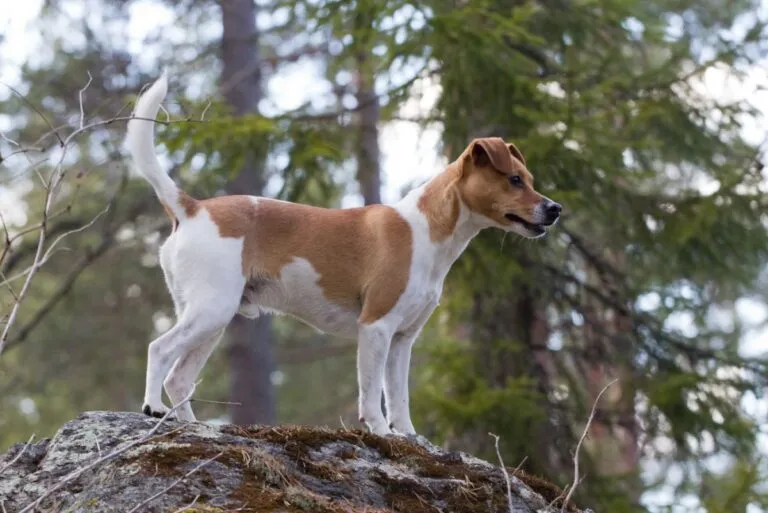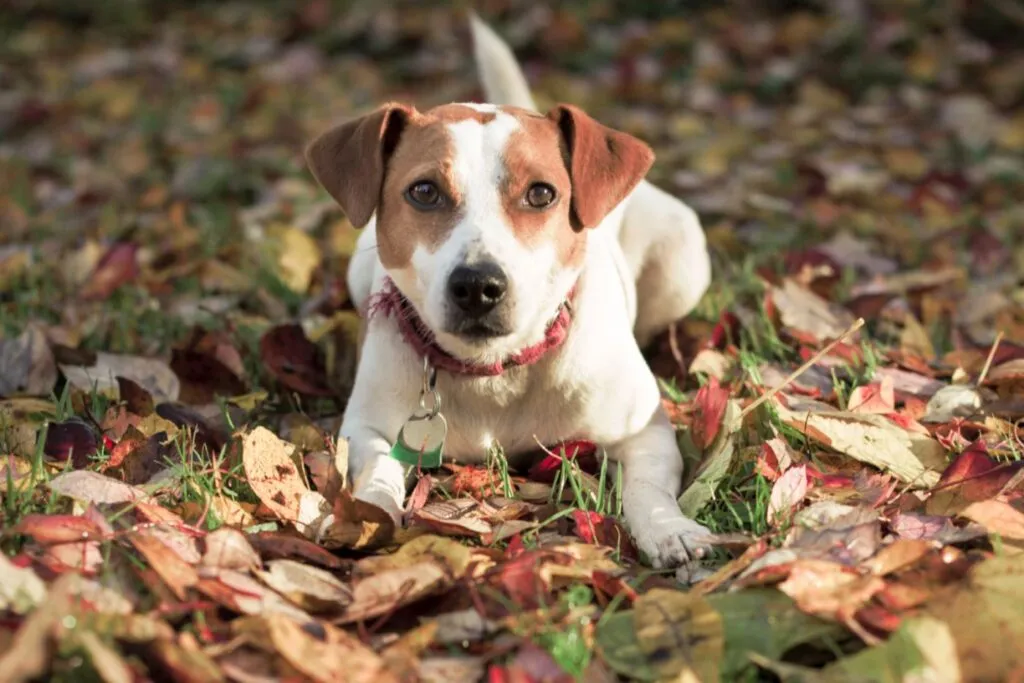Medium Size Poodle
The Danish Farmdog, also known as the Danish Swedish Farmdog, Danish Swedish Farmdog, Dansk Svensk Gardshund, or simply Dansky, was a diligent working dog in the past, freeing farms and stables of mice and rats. Today, this former working animal is considered an easy-care family pet, sure to bring delight to beginners as well.

© Sami Pietikäinen / stock.adobe.com
The Danish-Swedish Farmdog's coat colour and pattern is reminiscent of the Jack Russell Terrier.
Visually, the Dansky resembles the Jack Russell Terrier or Foxterrier. Its hard, short, smooth coat is predominantly white with spots and markings. Some individuals display ticking in brown, black, tan, or beige.
Males reach a size of 34 to 37 centimetres, while females are 32 to 35 centimetres tall. According to the breed standard, there is no specific bodyweight set for the Dansky breed. Typically, dogs of this breed weigh between seven and twelve kilograms.
The build of this little Scandinavian is compact and rather rectangular. The head appears quite small in relation to the body and has a lightly triangular shape. The friendly eyes of the Danish Swedish Farmdog are medium-sized and dark. Per the official breed description, its ears are rose-shaped or button-like. The neck is strong and arched, the chest is wide and deep, with a distinctly pronounced rib curvature. Typically, the tail is carried straight or with a slight curve.
 © Merry/stock.adobe.com
© Merry/stock.adobe.com
Though the Dansky might be mistaken for the more well-known Jack Russell Terrier due to its looks, the two breeds have little in common temperament-wise.
Indeed, the stocky Dansk Svensk Gardshund is more closely related to the Pinschers than to the Terriers. Hence, this dog breed is included by the Fédération Cynologique Internationale (FCI) in Group 2 “Pinscher and Schnauzer”.
Unlike the Jack Russell Terrier, a Danish Swedish Farmdog does not have a pronounced hunting drive. In the past, the breed was kept on Scandinavian farms to catch mice and rats. This dog, therefore, shows no interest in larger prey.
Even today, the lively, spirited Dansky likes to dig in the garden when it catches the scent of a rodent. However, outdoors, such as when acting as a sporty companion while jogging or cycling, it displays no excessive hunting behaviour.
Another role for this working dog in the past was to guard the home and farm. Accordingly, the Danish Swedish Farmdog often announces visitors with barking. However, it doesn’t yelp nor shows aggression towards strangers.
Nervousness is foreign to a species-appropriately cared-for Dansky. Even noise and unfamiliar situations usually don’t much faze this confident, strong character.
The affectionate, sociable Danish Swedish Farmdog loves to stay close to its two-legged pack. It’s considered the ideal family dog, as it is friendly, playful, and easy-going. It very much enjoys cuddles. The Dansk Svensk Gardshund gets along famously with children, provided parents teach their youngsters how to interact properly with the canine at an early age.
As an attentive farm and companion dog, the Dansky forms a strong bond with its family. It has a strong desire to please, which simplifies training. Therefore, a Danish Swedish Farmdog is also commendable for beginners.
However, novices should still seek advice from a dog trainer or attend a dog training school. That’s because clever Danskys might exploit training mistakes to sneak their way up the pack hierarchy.
Thanks to its intelligence, comprehension skills, and sensitivity, the Danish Farmdog learns quickly. It usually understands without trouble what its owner wants and exhibits the desired behaviour.
Small tricks and the motions of various dog sports such as Agility, Flyball, or Dog Dancing are quickly within its grasp.
With some patience and training, the people-oriented Dansky can even learn to stay home alone for a few hours a day. However, it shouldn’t be without its family for too long.
Due to its minimal hunting drive, the Danish Swedish Farmdog generally gets along well with cats and other pets. As it is not very aggressive and usually avoids conflict, this dog is also suitable for keeping in a pack. Even with breeds known to be more challenging, the amicable Dansky often has no issues.
To lead a happy dog life, the Danish Swedish Farmdog needs close contact with its family. It loves long walks in the countryside. If it is kept in a city, therefore, regular excursions to green spaces should be planned.
As mentioned, the Dansky sometimes acts as a “gardener”. If it senses mice or rats in its territory, it will dig up the garden, not sparing flower beds either. This behaviour can usually be trained out without much hassle. However, the Danish Farmdog should then be given the opportunity to indulge in its digging fascination during its extended walkabouts.
The Danish Farmdog is a relatively new dog breed. However, the history of its ancestors goes back to the Viking Age. The genetic diversity in breeding is high, which endows the Dansky with robust health.
Little is known about breed-specific diseases. Occasionally, avascular necrosis of the femoral head, also known as Calvé-Legg-Perthes disease, is observed, which is manifest by unilateral lameness and pain. It mostly affects small dog breeds and typically occurs in young dogs between three and ten months old.
With proper care, the Dansky reaches a ripe old age. The life expectancy of this dog breed is 12 to 15 years.
Like other dog breeds, the Danish-Swedish Farmdog needs a well-balanced diet with high-quality food.
Some individuals tend to wolf down their meals at a rapid pace. Treats like tripe or cowhide strips are also often gobbled up greedily. Therefore, owners should keep a watchful eye during feeding to be safe.
The Dansky’s short coat needs only minimal care. Occasional brushing, particularly during the shedding period, is perfectly sufficient.
Good to know: A plus point of this breed is its tidiness. Typically, Danskys do not develop the characteristic doggy odour.
The Dansk Svensk Gardshund was officially recognised by the FCI only in 2019. The breed originates from the small, robust farm and farm dogs that have been kept for a long time in Denmark and southern Sweden.
There they had, and still have, the task of guarding the yard and freeing it from pests like mice and rats. When many farms were abandoned during an interim period, this old Scandinavian dog breed nearly became extinct.
Thanks to Danish dog lovers, the Danish Swedish Farmdog survived. These dog fans used the last remaining individuals to establish a breeding programme, placing great emphasis on stable health and a friendly disposition.
In 1987, the Gardshund was finally recognised as an independent breed in Sweden and Denmark. At the World Dog Show in Copenhagen in 1989, the breed was presented to the general public. The population of this dog breed is now considered secure. However, outside of its Scandinavian home countries, the Dansky is not very widely spread.
Those wishing to buy a Dansky puppy will usually need to seek out a breeder. In animal shelters, this not very widespread breed is rather rare.
A healthy Dansky puppy from a reputable breeder with all papers costs at least 1,200 euros. Prices up to 2,500 euros or even 3,000 euros are not unusual.
If the breeder asks noticeably less for their puppy, prospective buyers should become wary. In such cases, it’s highly likely that the breeder favours quantity over quality to the animals’ detriment.
Particularly with supposed bargains on the internet, the utmost caution is advised. The puppies often come from inbreeding or are inadequately socialised. This can lead to health problems and behavioural issues, resulting in high vet costs.
Those seeking a small dog with the sought-after Jack Russell look will find a Danish Swedish Farmdog a commendable four-pawed roommate. Its scant hunting drive and easy trainability make the Dansky an exemplary pet, even for dog novices.
| Special features: | Originally, the Dansk Svensk Gardshund was kept as a farm dog in Scandinavia. Today, the former working dog is increasingly popular as a family pet due to its compact size and uncomplicated nature. |
| Character: | spirited, lively, people-oriented, intelligent, playful, affectionate, child-friendly, alert |
| Height at withers: | Males 34-37 cm, Females 32-35 cm |
| Weight: | 7-12 kg |
| Coat care: | low effort |
| Exercise needed: | needs a lot of activity and enjoys being on the move |
| Suitable for beginners: | yes |
| Barking: | barks little |
| Life expectancy: | 12-15 years |
| Typical diseases: | robust breed, no known hereditary diseases |
| Price: | from €1,200 |
| FCI Group: | 2 “Pinscher and Schnauzer” |
| Exercise requirements: | medium |
| Origin: | southern Sweden and Denmark |
Here are some purchase proposals curated by the zooplus editorial team
The products featured have been carefully selected by our editorial staff and are available at the zooplus online pet shop. The selection does not constitute advertising for the mentioned brands.
Fans of the Bearded Collie agree that those who aren't familiar with this dog breed simply have to get acquainted with it. And those who have experienced how a Bearded Collie bolts across meadows with its flowing fur, how it rolls around full of energy and joy and how it attentively and observantly takes into account its owners wishes become simply addicted to this original dog breed and its unique charm.
The Goldendoodle isn't a breed, but a pairing between Golden Retrievers and Medium or Standard Poodles. Marketed as a low-maintenance dog for allergy sufferers, this hybrid is enjoying increasing popularity amongst dog lovers, similar to the Labradoodle.